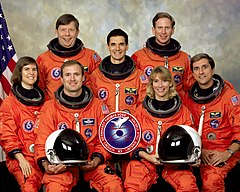STS-83
 | |
| Dane misji | |
| Indeks COSPAR | 1997-013A |
|---|---|
| Zaangażowani | |
| Oznaczenie kodowe | STS-83 |
| Pojazd | |
| Wahadłowiec | Columbia |
| Załoga | |
 Siedzą od lewej: Janice Voss, James Halsell, Susan Still, Donald A. Thomas. Stoją od lewej: Roger Crouch, Gregory Linteris, Michael Gernhardt. | |
| Dowódca | James Halsell |
| Start | |
| Miejsce startu | Stany Zjednoczone, KSC, LC39-A |
| Początek misji | 4 kwietnia 1997 19:20:32 UTC |
| Orbita okołoziemska | |
| Apogeum | 302 km |
| Perygeum | 298 km |
| Okres orbitalny | 90,5 min |
| Inklinacja orbity | 28,5° |
| Lądowanie | |
| Miejsce lądowania | KSC, Pas startowy 15 |
| Lądowanie | 8 kwietnia 1997 18:33:11 UTC |
| Czas trwania misji | 3 dni, 23 godz., 12 min, 39 sek[1] (planowana na 15 dni 16 godz.) |
| Przebyta odległość | 2,4 mln km[2] |
| Liczba okrążeń Ziemi | 63[2] |
| Program lotów wahadłowców | |
STS-83 (ang. Space Transportation System) – dwudziesta druga misja amerykańskiego wahadłowca kosmicznego Columbia i osiemdziesiąta trzecia programu lotów wahadłowców[3].
Załoga
- źródło[3]
- James Halsell (3)*, dowódca (CDR)
- Susan Kilrain (1), pilot (PLT)
- Janice Voss (3), dowódca ładunku (MS1)
- Donald A. Thomas (3), specjalista misji (MS3)
- Michael Gernhardt (2), specjalista misji (MS2)
- Roger Crouch (1), specjalista ładunku (PS1)
- Gregory Linteris (1), specjalista ładunku (PS2)
- *(liczba w nawiasie oznacza liczbę lotów odbytych przez każdego z astronautów)
Parametry misji
- Masa:
- startowa orbitera: - ? kg
- lądującego orbitera: 117 802 kg
- Moduł MSL-1 Spacelab: 10 169 kg
- Perygeum: 298 km[1]
- Apogeum: 302 km[1]
- Inklinacja: 28,5°[1]
- Okres orbitalny: 90,5 min[1]
Cel misji
Lot naukowy z laboratorium Spacelab MSL (Microgravity Science Laboratory)[3].
Przebieg misji
Misja miała dość dramatyczny przebieg mimo bezproblemowego początku. Po kilku godzinach pobytu w kosmosie pojawiły się problemy z jednym z trzech ogniw paliwowych. Załoga z pomocą techników na Ziemi nie potrafiła usunąć usterki. Ogniwo zostało wyłączone. Konsekwencje awarii spowodowały skrócenie misji z planowanych szesnastu dni do zaledwie czterech. Astronautom we znaki dawał się niedobór energii, poza tym NASA obawiała się wybuchu uszkodzonego ogniwa. W związku z tym, że nie osiągnięto żadnego z celów misji, NASA podjęła bezprecedensową decyzję: po usunięciu awarii lot wahadłowca został powtórzony. Z tą samą załogą i takim samym ładunkiem Columbia wystartowała 1 lipca 1997 r. (STS-94). Lot ten przebiegł zgodnie z planem[3].
Zobacz też
Przypisy
Linki zewnętrzne
- podsumowanie misji STS-83 na stronie KSC (ang.)
- Mark Wade: STS-83 (ang.). W: Encyclopedia Astronautica [on-line]. [dostęp 2017-07-25].
- Spaceflight mission report: STS-83 (ang.). Spacefacts. [dostęp 2017-07-25].
Media użyte na tej stronie
The flag of Navassa Island is simply the United States flag. It does not have a "local" flag or "unofficial" flag; it is an uninhabited island. The version with a profile view was based on Flags of the World and as a fictional design has no status warranting a place on any Wiki. It was made up by a random person with no connection to the island, it has never flown on the island, and it has never received any sort of recognition or validation by any authority. The person quoted on that page has no authority to bestow a flag, "unofficial" or otherwise, on the island.
The crew patch for NASA's STS-83 mission depicts the Space Shuttle Columbia launching into space for the first Microgravity Sciences Laboratory 1 (MSL-1) mission. MSL-1 investigated materials science, fluid dynamics, biotechnology, and combustion science in the microgravity environment of space, experiments that were conducted in the Spacelab Module in the Space Shuttle Columbia's cargo bay. The center circle symbolizes a free liquid under microgravity conditions representing various fluid and materials science experiments. Symbolic of the combustion experiments is the surrounding starburst of a blue flame burning in space. The 3-lobed shape of the outermost starburst ring traces the dot pattern of a transmission Laue photograph typical of biotechnology experiments. The numerical designation for the mission is shown at bottom center. As a forerunner to missions involving International Space Station (ISS), STS-83 represented the hope that scientific results and knowledge gained during the flight will be applied to solving problems on Earth for the benefit and advancement of humankind.
Five NASA astronauts and two scientists comprised the crew for the STS-83 and STS-94 missions in support of the first Microgravity Sciences Laboratory 1 (MSL-1). Pictured on the front row (left to right) are Janice E. Voss, payload commander; James D. Halsell, commander; Susan L. Still, pilot; and Donald A. Thomas, mission specialist. On the back row (left to right) are payload specialists Roger K. Crouch, and Gregory T. Linteris; and Michael L. Gernhardt, mission specialist. Dr. Crouch and Dr. Linteris are experts in several disciplines treated on MSL-1. STS-83 launched aboard the Space Shuttle Columbia on April 4, 1997. The five launched again in July 1997 for the STS-94 mission.


